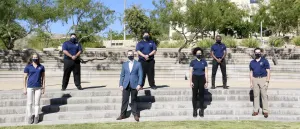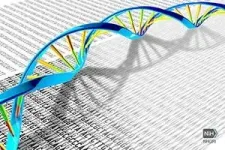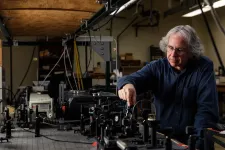UTEP survey reveals hidden health and wellness benefits of COVID-19 pandemic
2021-02-25
(Press-News.org) EL PASO, Texas - A study by physiology researchers at The University of Texas at El Paso found that El Paso's stay-at-home ordinance due to the COVID-19 pandemic had positive effects on the health and well-being of the region's residents.
Despite a shutdown of gyms and movement restrictions on non-essential activities, residents increased their fitness activity and closely monitored their food and nutrition intake, said Cory M. Smith, Ph.D., assistant professor of kinesiology in UTEP's College of Health Sciences and the study's principal investigator.
More than 1,300 El Paso and Las Cruces, New Mexico, residents participated in Smith's COVID-19 Survival Survey during the month of September 2020. Questions focused on their personal changes in physical activity, nutritional habits, and changes in thoughts and attitudes toward common hygiene practices and emergency preparedness in response to the COVID-19 pandemic and the El Paso County's Work Safe, Stay Home order that went into effect March 24, 2020.
According to the data, 37% of participants said they improved their exercise practices by changing their exercise focus, exercising more and trying new fitness activities, and 15% said they increased their outdoor recreation activities. Forty-five percent of residents responded that they increased self-monitoring of their food intake.
"We hypothesized that people were going to exercise less during the pandemic after gyms and fitness facilities were shut down," said Smith, director of UTEP's Human and Environmental Physiology Laboratory (HEPL). "But when we began to evaluate the data, we found some hidden health benefits of the pandemic. People were exercising more and eating better. Hopefully, this data will give us a better understanding of how people react during a public health crisis and how we can better prepare for future public health emergencies."
Smith attributed the study's positive health outcomes to people's increased awareness of the risk factors associated with COVID-19, a highly contagious respiratory illness caused by the SARS-CoV-2 virus.
Before El Paso implemented the stay-at-home order, 39% of participants reported a high level of concern for contracting COVID-19 compared with 50% of individuals who reported a low level of concern for catching coronavirus. Eleven percent indicated they were not concerned.
After the order went into effect, the number of respondents who had a high level of concern for contracting COVID-19 increased to 57%. Individuals who reported a low level of concern for the virus dropped to 39%, and 4% of participants reported no concern.
The survey revealed that residents who felt sick were more likely to stay home and not go to work, school, or social events after the stay-at-home order. In addition, the implementation of the Stay at Home Ordinance increased handwashing and sanitizing frequency in 92% of individuals.
Data on changes in employment, nutrition habits and physical activity are also included in the survey.
Smith planned to share the results with the City of El Paso. He said data could be used to improve community protocols to better enforce public safety guidelines in the event of a future pandemic.
INFORMATION:
The University of Texas at El Paso is one of the largest and most successful Hispanic-serving institutions in the country, with a student body that is 83% Hispanic. It enrolls nearly 25,000 students in 166 bachelor's, master's and doctoral programs in 10 colleges and schools. With more than $100 million in total annual research expenditures, UTEP is ranked in the top 5% of research institutions nationally and fifth in Texas for federal research expenditures at public universities.
[Attachments] See images for this press release:

ELSE PRESS RELEASES FROM THIS DATE:
2021-02-25
Researchers at the University of Maryland School of Medicine (UMSOM) co-authored a study, published today in the journal Science, that details the sequencing of 64 full human genomes. This reference data includes individuals from around the world and better captures the genetic diversity of the human species. Among other applications, the work will enable population-specific studies on genetic predispositions to human diseases as well as the discovery of more complex forms of genetic variation.
Twenty years ago this month, the International Human Genome Sequencing Consortium announced the first draft of the human genome reference sequence. The Human Genome Project, as it was called, required 11 years of work and involved more than 1000 ...
2021-02-25
Psychologists have long found that people behave differently than when they learn of peers' actions. A new study by computer scientists found that when individuals in an experiment about autonomous vehicles were informed that their peers were more likely to sacrifice their own safety to program their vehicle to hit a wall rather than hit pedestrians who were at risk, the percentage of individuals willing to sacrifice their own safety increased by approximately two-thirds.
As computer scientists train machines to act as people's agents in all sorts of situations, the study's authors indicate that the social component of decision-making is often overlooked. This could be of great consequence, note the paper's authors who show that the trolly problem -long shown to be ...
2021-02-25
States regularly use administrative records, such as motor-vehicle data, in determining whether people have moved to prune their voter rolls. A Yale-led study of this process in Wisconsin shows that a significant percentage of registered voters are incorrectly identified as having changed addresses, potentially endangering their right to vote.
The study, published in the journal Science Advances, found that at least 4% of people listed as suspected "movers" cast ballots in 2018 elections using addresses that were wrongly flagged as out of date. Minority voters were twice as likely as white voters to cast their ...
2021-02-25
The COVID-19 virus holds some mysteries. Scientists remain in the dark on aspects of how it fuses and enters the host cell; how it assembles itself; and how it buds off the host cell.
Computational modeling combined with experimental data provides insights into these behaviors. But modeling over meaningful timescales of the pandemic-causing SARS-CoV-2 virus has so far been limited to just its pieces like the spike protein, a target for the current round of vaccines.
A new multiscale coarse-grained model of the complete SARS-CoV-2 virion, its core genetic material and virion shell, has been developed for the first time using supercomputers. The model offers ...
2021-02-25
Litter is not only a problem on Earth. According to NASA, there are currently millions of pieces of space junk in the range of altitudes from 200 to 2,000 kilometers above the Earth's surface, which is known as low Earth orbit (LEO). Most of the junk is comprised of objects created by humans, like pieces of old spacecraft or defunct satellites. This space debris can reach speeds of up to 18,000 miles per hour, posing a major danger to the 2,612 satellites that currently operate at LEO. Without effective tools for tracking space debris, parts of LEO may even become too hazardous for satellites.
In a paper publishing today in the SIAM Journal on Imaging Sciences, Matan Leibovich (New York University), George Papanicolaou (Stanford University), and Chrysoula Tsogka (University of California, ...
2021-02-25
The unprecedented cost of the 2018 Kilauea eruption in Hawai'i reflects the intersection of distinct physical and social phenomena: infrequent, highly destructive eruptions, and atypically high population growth, according to a new study published in Nature Communications and led by University of Hawai'i at Mānoa researchers.
It has long been recognized that areas in Puna, Hawai'i, are at high risk from lava flows. This ensured that land values were lower in Puna--which lies within the three highest risk lava hazard zones 1, 2 and 3--which actively promoted rapid population ...
2021-02-25
Our body consists of 100 trillion cells that communicate with each other, receive signals from the outside world and react to them. A central role in this communication network is attributed to receiver proteins, called receptors, which are anchored at the cell membrane. There, they receive and transmit signals to the inside of the cell, where a cell reaction is triggered.
In humans, G protein-coupled receptors (GPC receptors) represent the largest group of these receptor molecules, with around 700 different types. The research of the Frankfurt and Leipzig scientists focused on a GPC receptor that serves as a receptor for the ...
2021-02-25
Timothy Callaghan, PhD, and Alva Ferdinand, DrPH, JD, from the Southwest Rural Health Research Center at Texas A&M University School of Public Health, joined colleagues in the first national study of how often people in urban and rural areas in the United States follow COVID-19 guidelines. These include public health best practices like wearing masks in public, sanitizing homes and work areas, maintaining physical distancing, working from home and avoiding dining in restaurants or bars.
The research team used a survey of 5,009 U.S. adults that closely matched the makeup of the country's population as a whole. The survey asked how often participants followed COVID-19 prevention recommendations and collected data on political ideology, perceived risk ...
2021-02-25
ITHACA, N.Y. - A team from Cornell University's Environmental Systems Lab, led by recent graduate Allison Bernett, has put forth a new framework for injecting as much information as possible into the pre-design and early design phases of a project, potentially saving architects and design teams time and money down the road.
"(Our framework) allows designers to understand the full environmental impact of their building," said Bernett, corresponding author of "Sustainability Evaluation for Early Design (SEED) Framework for Energy Use, Embodied Carbon, Cost, and Daylighting Assessment" which published Jan. 10 in the Journal of ...
2021-02-25
WEST LAFAYETTE, Ind. -- Doppler radar improves lives by peeking inside air masses to predict the weather. A Purdue University team is using similar technology to look inside living cells, introducing a method to detect pathogens and treat infections in ways that scientists never have before.
In a new study, the team used Doppler to sneak a peek inside cells and track their metabolic activity in real time, without having to wait for cultures to grow. Using this ability, the researchers can test microbes found in food, water, and other environments to see if they are pathogens, or help them identify the right medicine to treat antibiotic-resistant bacteria.
David Nolte, Purdue's Edward ...
LAST 30 PRESS RELEASES:
[Press-News.org] UTEP survey reveals hidden health and wellness benefits of COVID-19 pandemic




